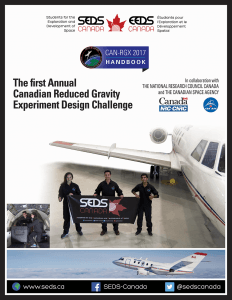Students for the Exploration and Development of Space (SEDS) is a national nonprofit organization that was founded in the 1980s by Peter Diamandis, Bob Richards, and Todd Hawley. It began with a single chapter at Princeton and has since grown to consist of students from high school through graduate school with chapters in North America, Europe, the Middle East, Asia, and Africa. The organization looks to aid in the development of technical and leadership skills through the provision of opportunities for student members to attend conferences, publish work, and grow their professional networks.
Recently, the Canadian chapters participated in an initiative called the Canadian Reduced Gravity Experiment Design Challenge (CAN-RGX). This initiative was searching for student ideas regarding experiments with significant promise that required testing in a reduced gravity environment. From the many entries that were submitted, four have been selected as finalists for testing — and among those four are two experiments involving 3D printing.
Rather than shooting the student researchers into space, something as yet not quite as feasible as the movies might make it seem, the finalists will have the opportunity to operate their experimental projects aboard a Falcon 20 research aircraft owned by the National Research Council of Canada (NRC). What makes this plane so special is that it can execute parabolic maneuvers. These runs are ones in which the plane both ascends and descends at a very high rate of speed, leaving its occupants free to experience a reduced gravity environment. The plane will execute these parabolic flight patterns 12 times each to provide sufficient time to conduct the student experiments.
 This type of flight experience is one that is regularly used to prepare astronauts for living and working in space and is not an experience to be taken lightly. It is also not an opportunity likely to reoccur and so hopefully is something that can be handled by the stomachs of the student researchers. I, for one, am feeling slightly nauseous just thinking about it and may need to wear motion sickness bands just to complete this article.
This type of flight experience is one that is regularly used to prepare astronauts for living and working in space and is not an experience to be taken lightly. It is also not an opportunity likely to reoccur and so hopefully is something that can be handled by the stomachs of the student researchers. I, for one, am feeling slightly nauseous just thinking about it and may need to wear motion sickness bands just to complete this article.
It has been recognized that there are many advantages that 3D printing can provide to space exploration both in terms of what can be created here below and what can be manufactured in the expanse of outer space. It should come as no surprise then that two of the four finalists teams are working with experiments involving the technology.
Team iSSELab (Interfacial Science and Surface Engineering Lab), hailing from the University of Alberta, will be collecting data regarding alterations in the process of crystallization undergone by 3D printing materials in the reduced gravity environment provided by the parabolic flight.
 Team AVAIL (Analyzing Viscosity and Inertia in Liquids) from the University of Toronto has proposed that liquids, when printed in space, will sustain a longer column before finally buckling as a result of the reduced gravity. They will collect data from experiments designed to measure column lengths, thus contributing to the understanding of the performance of the 3D printing in outer space.
Team AVAIL (Analyzing Viscosity and Inertia in Liquids) from the University of Toronto has proposed that liquids, when printed in space, will sustain a longer column before finally buckling as a result of the reduced gravity. They will collect data from experiments designed to measure column lengths, thus contributing to the understanding of the performance of the 3D printing in outer space.
Having been selected as a finalist, there is still a great deal of work to be done in order to prepare for the test flight. In this next phase of preparation called the Preliminary Design Review, each will present their experimental designs for evaluation by a panel of expert judges. They will then be given six weeks to bring their experiments from paper into physical space in order to undergo a final review before the flights which are currently scheduled for the first week in August 2017. Discuss in the Design Challenge forum at 3DPB.com.
Subscribe to Our Email Newsletter
Stay up-to-date on all the latest news from the 3D printing industry and receive information and offers from third party vendors.
Print Services
Upload your 3D Models and get them printed quickly and efficiently.
You May Also Like
Making Space: Stratasys Global Director of Aerospace & Defense Conrad Smith Discusses the Space Supply Chain Council
Of all the many verticals that have been significant additive manufacturing (AM) adopters, few have been more deeply influenced by the incorporation of AM into their workflows than the space...
EOS in India: AM’s Rising Star
EOS is doubling down on India. With a growing base of aerospace startups, new government policies, and a massive engineering workforce, India is quickly becoming one of the most important...
PostProcess CEO on Why the “Dirty Little Secret” of 3D Printing Can’t Be Ignored Anymore
If you’ve ever peeked behind the scenes of a 3D printing lab, you might have caught a glimpse of the post-processing room; maybe it’s messy, maybe hidden behind a mysterious...
Stratasys & Automation Intelligence Open North American Tooling Center in Flint
Stratasys has opened the North American Stratasys Tooling Center (NASTC) in Flint, Michigan, together with automation integrator and software firm Automation Intelligence. Stratasys wants the new center to help reduce...


































